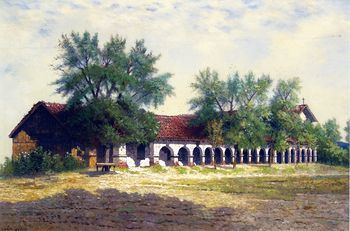Mission San Juan Bautista
 Mission San Juan Bautista, circa 1899.[1] | |
| HISTORY | |
|---|---|
| Location: | San Juan Bautista, California |
| Coordinates: | 36° 50′ 42.3″ N, 121° 32′ 9.2″ W |
| Name as Founded: | La Misión del Glorios Precursor de Jesu Cristo, Nuestro Señor, San Juan Bautista [2] |
| English Translation: | The Mission of the Glorious Precursor of Jesus Christ, Our Lord, Saint John the Baptist |
| Patron Saint: | Saint John the Baptist [3] |
| Nickname(s): | "Mission of Music" [4] |
| Founding Date: | June 24, 1797 [5] |
| Founded By: | Father Fermín Lasuén [6] |
| Founding Order: | Fifteenth [3] |
| Military District: | Third [7] |
| Native Tribe(s): Spanish Name(s): |
Ohlone (Mutsun), Yokuts Costeño |
| Primordial Place Name(s): | Popeloutchom [8] |
| SPIRITUAL RESULTS | |
| Baptisms: | 4,106 [9] |
| Marriages: | 1,003 [9] |
| Burials: | 2,854 [9] |
| Year of Neophyte Population Peak: | 1823 [10][11] |
| Neophyte Population: | 916 [10][11] |
| Neophyte Population in 1832: | 1,248 [10][11] |
| DISPOSITION | |
| Secularized: | 1835 [3] |
| Returned to the Church: | 1859 [3] |
| Caretaker: | Roman Catholic Diocese of Monterey |
| Current Use: | Parish Church |
| California Historical Landmark: | #195 |
| Web Site: | http://www.oldmissionsjb.org/ |
Mission San Juan Bautista is a former religious outpost established by Spanish colonists on the west coast of North America in the present-day State of California. Founded on June 24, 1797 by Roman Catholics of the Franciscan Order, the settlement was the the fifteenth in the twenty-one mission Alta California chain. Named for John the Baptist, the Mission was sited directly atop the San Andreas Fault. Designated as a California Historical Landmark, today the Mission operates as a parish church within the Roman Catholic Diocese of Monterey.
Other missions bearing the name San Juan Bautista include:
- Misión San Juan Bautista Malibat (Misión Liguí) in Baja California Sur, and
Misión San Juan Bautista in Coahuila, Mexico.
History
Mission Period (1769 – 1833)
Barracks for the soldiers, a nunnery, the Jose Castro House, and other buildings were constructed around a large grassy plaza in front of the church and can be seen today in their original form. The Ohlone, the original residents of the valley, were converted and brought to live at the Mission, followed by Yokuts from the Central Valley. Mission San Juan Bautista has served mass daily since 1797.
Father Pedro Estévan Tápis (who had a special talent for music) joined Father de la Cuesta at Mission San Juan Bautista in 1815 to teach singing to the Indians. He utilized a system of notation developed in Spain that assigned colors to different types of music notes which made it easier for the novices to follow. His choir of Native American boys performed for many visitors, earning the San Juan Bautista Mission the nickname the "Mission of Music." Two of his handwritten choir books are preserved at the San Juan Bautista Museum. When Father Tapis died in 1825 he was buried on the Mission grounds. The town of San Juan Bautista, which grew up around the Mission, expanded rapidly during the California Gold Rush and continues to be a thriving community today.
Rancho Period (1834 – 1849)
California Statehood (1850 – 1900)
The structures suffered extensive damage in the earthquakes of 1800 and 1906; the Mission was restored initially 1884, and then again in 1949 with funding from the Hearst Foundation. The Mission was built on the San Andreas Fault and has suffered damage from numerous earthquakes over the years, but it has never been demolished. An unpaved stretch of the original El Camino Real, just east of the Mission, lies on a fault scarp.[12]
20th century and beyond (1901 – present)
Legacy
The Mission and its grounds were featured prominently in the 1958 Alfred Hitchcock film Vertigo. A steeple, added sometime after the Mission's original construction and secularization had been demolished following a fire, so Hitchcock added a "bell tower" using scale models, matte paintings, and trick photography at the Paramount Pictures studio in Los Angeles.
Other designations
- National Register of Historic Places #NPS-69000038 — San Juan Bautista Plaza / San Juan Bautista Plaza Historic District
Notes and references
- ↑ (PD) Painting: Edwin Deakin
- ↑ Bennett 1897b, p. 153
- ↑ 3.0 3.1 3.2 3.3 Krell, p. 241
- ↑ Ruscin, p. 121
- ↑ Yenne, p. 132
- ↑ Ruscin, p. 196
- ↑ Forbes, p. 202
- ↑ Ruscin, p. 195
- ↑ 9.0 9.1 9.2 Krell, p. 315: as of December 31, 1832; information adapted from Engelhardt's Missions and Missionaries of California.
- ↑ 10.0 10.1 10.2 Krell, p. 315: Information adapted from Engelhardt's Missions and Missionaries of California.
- ↑ 11.0 11.1 11.2 Engelhardt 1920, pp. 300-301
- ↑ Robert Iacopi, Earthquake Country (Menlo Park:Lane Publishing, 1964, 1971)